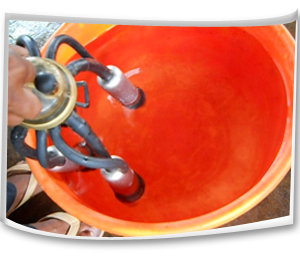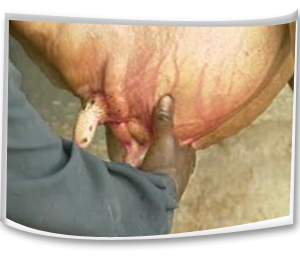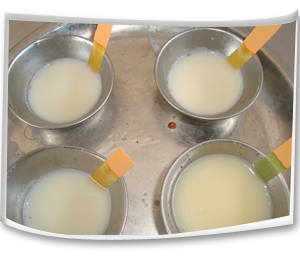|
Mastitis
| Nature of disease |
|
- Mastitis is the inflammatory condition of the udder irrespective of causes.
- It manifests the changes in the milk colour and consistency.
- Milk yield reduces abruptly and results in heavy economic loss.
- High yielding dairy cows are more commonly affected than low yielders.
- Exotic and cross bred cows are more prone to mastitis than the Indian zebu cows.
|
| Causes |
|
- A large number of species of microorganisms have been implicated as causes of mastitis. They are bacteria, fungus, Mycoplasma and virus.
- The most important bacterial organisms causing mastitis are Staphylococcus aureus; Str. agalactiae; Str.zooepidemicus; Str.faecalis; Str. pyogenes; Klebsiella spp; Mycobacterium bovis; E.coli; Brucella abortus; Pseudomonas pyocyaneus; Leptospira pomona; Pasteurella multocida.
- The fungal organisms responsible for mastitis are Trichosporon spp; Aspergillus fumigatus; A.midulus; Candida spp;
- Hygiene, trauma, complete milking and teat injuries may predispose this condition.
|
 |
| Mode of Transmission |
|
 |
- Through the teat canal infection reaches the mammary gland.
- The normal inhabitant of udder and environment like Str. Agalactiae, Stap.aureus, E.coli and Ps.pyocyaneus under favourable conditions multiply and invade the tissues produce much damaging effect.
- The cutaneous surface of the cow may have many organisms as resident population and from where the organisms may have the chance of invade through contamination by handlers.
- The contamination of milker’s hands, clothes and machine cup by milk from the affected quarter may lead to the spread of the disease to other non-infected teats of cow.
- Fly and other insects may also spread the infection from one place to the other.
- Spread of infection is possible through bedding ground by discharges of affected gland.
|
|
 |
| Clinical symptoms |
|
- Swelling of udder as a hard mass.
- Swollen udder with hot and pain while touching it.
- Animal will not allow touching the udder and will kick while touching it.
- Swollen and reddening of teats.
- Milk mixed with blood.
- Milk mixed with yellow or brown fluid with flakes or clots with foul smelling.
- Reduced milk yield.
|
 |
|
 |
| Preventive measures |
|
- Cow should be allowed in soft bedding following parturition.
- Concrete floor should be avoided especially in case of high yielder. Bedding should be done with straw, saw dust or sand. Sand is the ideal bedding material since it has lower bacterial count.
- Infusion should be used in each cow at dried off.
- Always the animal sheds should be clean.
- Washing the udder and hand of the milker with antiseptic lotion (4% Pottasium permanganate solution) before and after milking.
- The floor of the milking shed should be washed with running water.
- The milker’s hand should be free from nail.
- Cleaning and disinfecting milking machine and the teat cup, vessels after each milking.
- The healthy non-infected cows should be milked first and known infected cows should be milked at last.
- Newly introduced cow should be milked separately and should be screened through California Mastitis Test (CMT).
- The first strip of milk should not be allowed to fall on the floor; they may be stripped in separate container along with disinfectants in it.
- Dipping of all teats following each milking with iodophor solution containing 1% available iodine or hypochlorite solution and Chlorhexidine in 0.5% to 1% polyvenylpyrrolidine solution.
- Immediately after milking should not allow the animal to lie-down by engaging with fodder.
- The milking timings should be in a regular manner.
- The complete milking should be done at every time and milk should not be stored in teats.
- The udder and teats should be protected from any injuries.
- Hygienic measures at milking time, udder preparation before milking, post milking teat disinfections have been recommended as preventive measures.
- Control of fly population should be attempted, for these insecticides fly repellent sprays are to be made in the house and surroundings.
- The frequently affected animals should be removed from the herd.
|
 |

|
 |
| |
Suggested first aid |
- Application of ice cubes on the udder surface.
- The milk from infected teat should be milked out daily three times and disposed safely outside.
- Calf should not be allowed to suck the infected teat.
- Antibiotic treatment and consultation should be made with qualified veterinary Doctor.
|
| Control measures |
|
 |
- Immediately after detecting clinical signs, it should be consulted with qualified veterinarian for further antibiotic treatment.
- The infected animal should be kept separately from other animals.
- The calf should not be allowed to suck the infected teats.
- The milk from infected teat should be milked out daily three times and disposed properly without contaminate the environment.
- Mastitis milk should be properly disposed. 5% phenol may be added to the infected milk at the time of disposal.
- The healthy non-infected cows should be milked first and known infected cows should be milked at last.
- The non-responsive quarter should be permanently dried up
|
|
 |
|